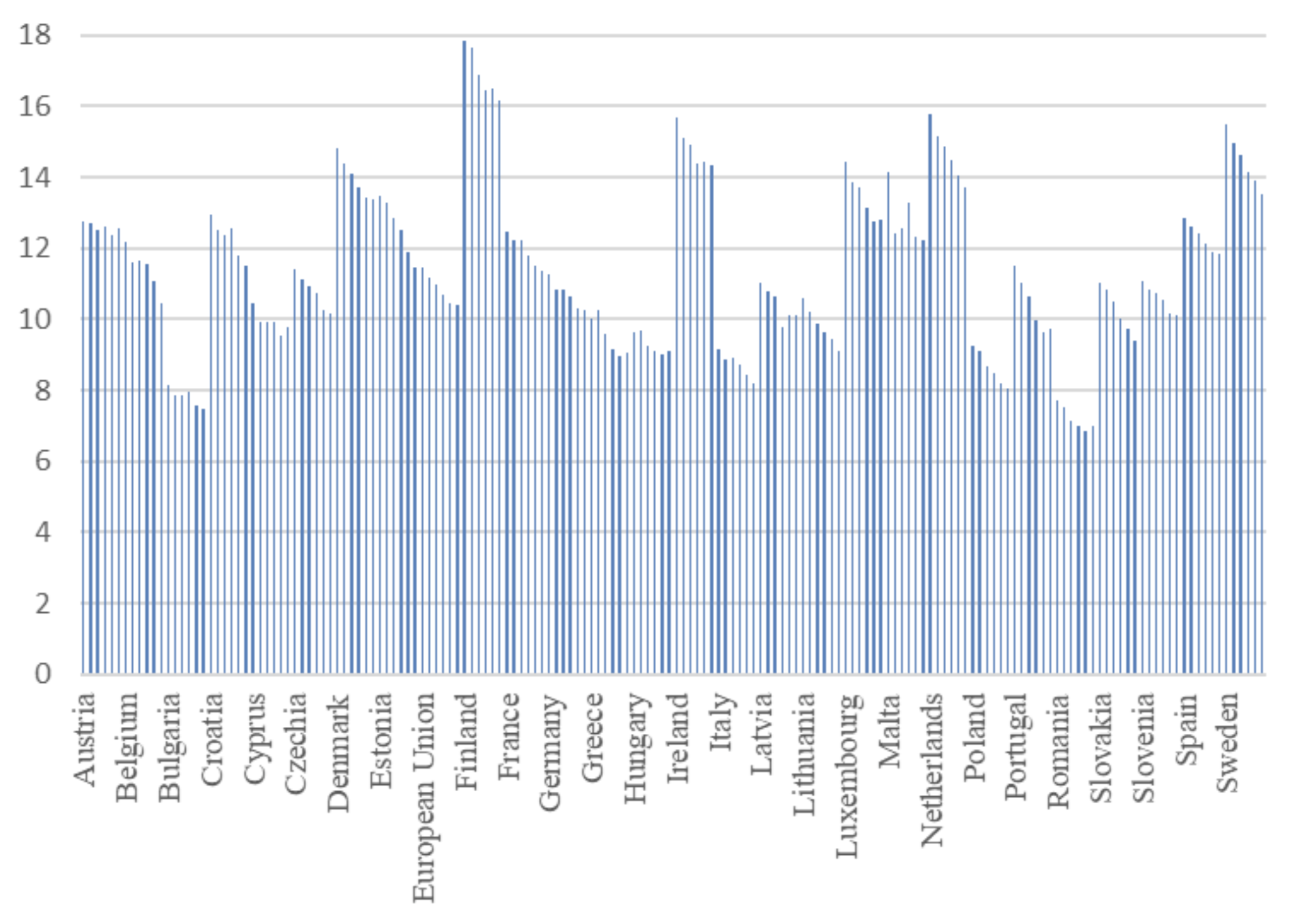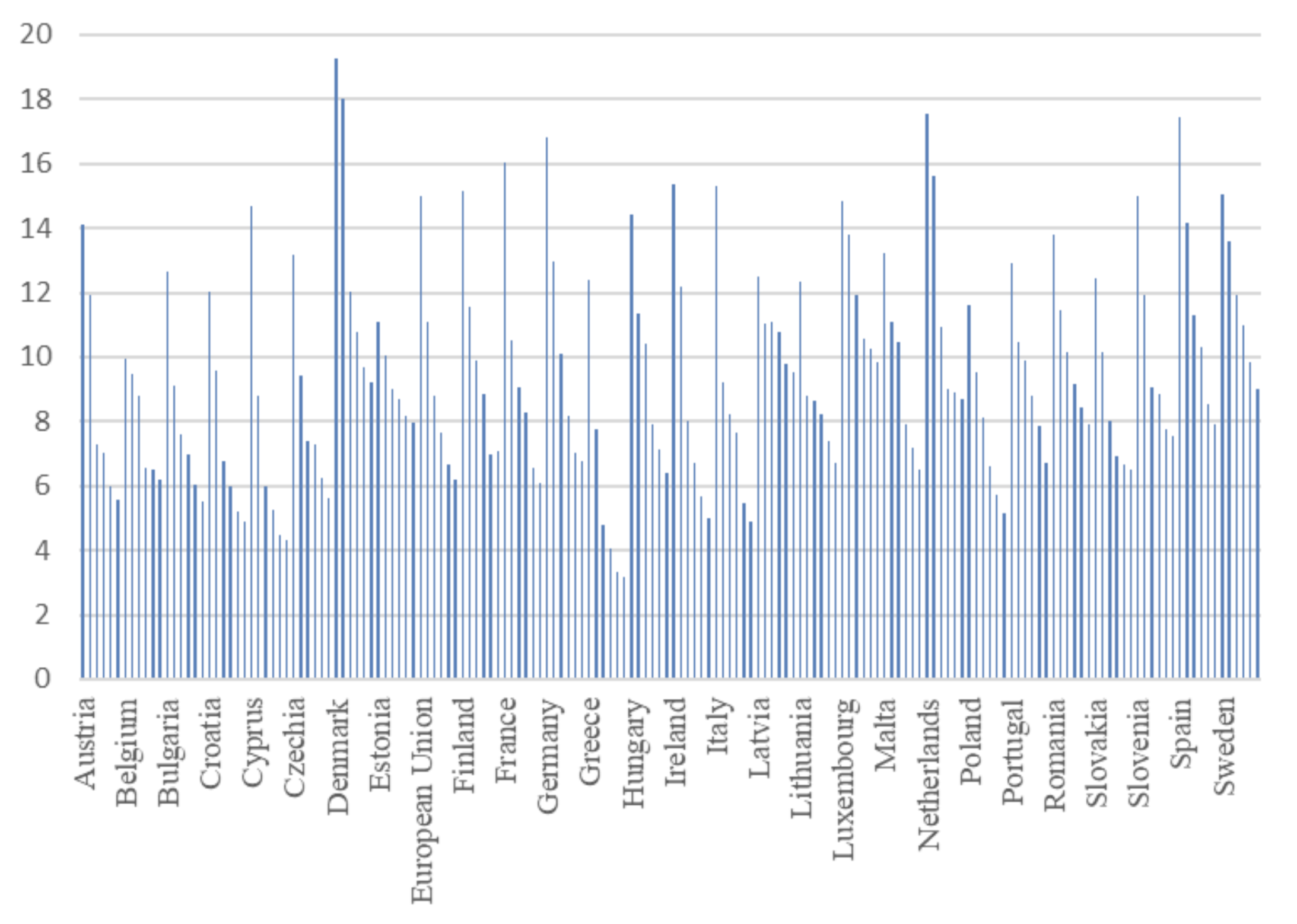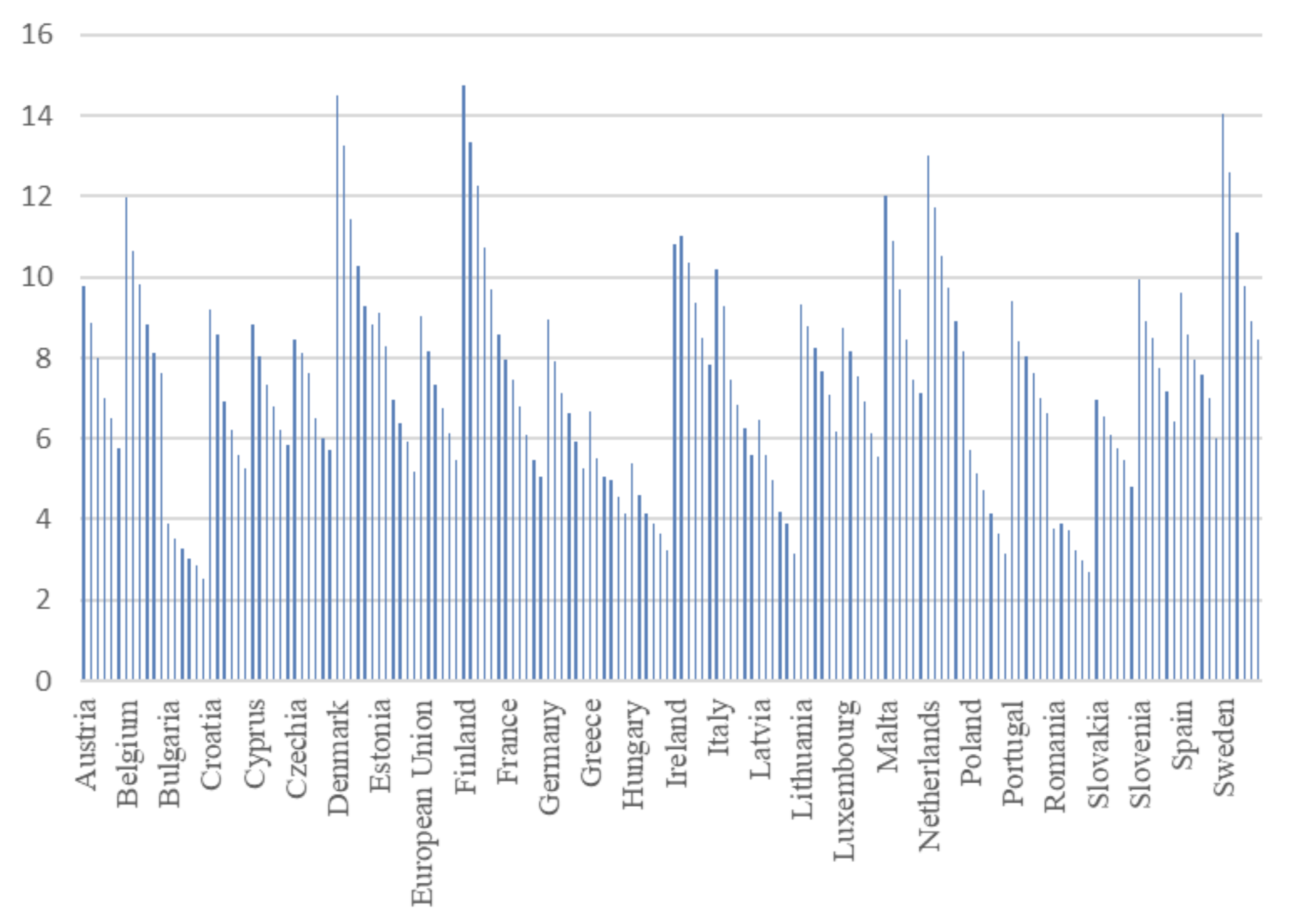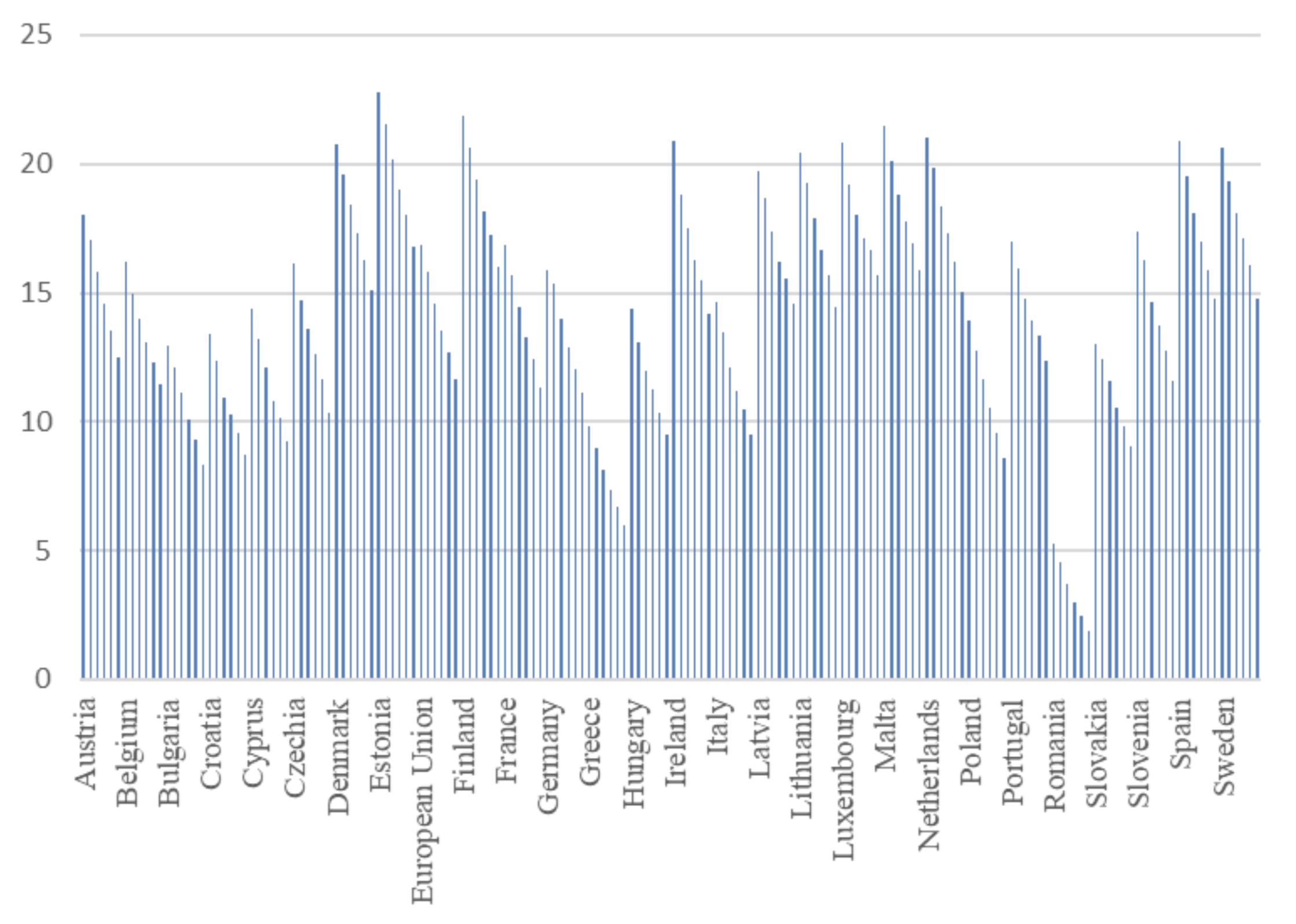Bridging the Digital Divide: The Relevance of Digital Transformation in the EU Public Sector
Alexandra Dragus
Abstract
Digital transformation is essential for enhancing efficiency in the public sector. This paper analyzes the impact of the Digital Economy and Society Index (DESI) on the public sector in 27 EU countries from 2016 to 2022. Through a systematic literature review and quantitative analysis, we explore key aspects of digitalization, including e-governance and digital service delivery. Our findings highlight a digital divide, with Nordic and Western European countries leading in DESI scores, while Eastern Europe faces challenges like brain drain and infrastructure deficits. The study provides policy recommendations to address these gaps, emphasizing the need for investments in digital infrastructure and human capital.
1. Introduction
The digital revolution has become a widespread force in a period of fast technology growth transforming businesses, economies, and communities worldwide. The public sector which has historically been known for its bureaucratic structures and labor-intensive processes is now being forced to change to keep up with the times due to the digital revolution. The use of digital technology by the public sector, sometimes known as "digital transformation," has become a popular strategy for enhancing government operations, increasing efficiency, and increasing citizen participation (Agostino et al., 2020).
A wide range of topics are covered by digital transformation in the public sector including but not limited to e-governance, digital service delivery, data-driven decision-making, open data initiatives, and the creation of smart cities. Governments may improve their efficiency, efficacy, and responsiveness in providing residents with public services by utilizing digital tools and technology. The digital transformation of the public sector has the ability to redefine governance and reshape the connection between governments and citizens by streamlining bureaucratic processes and enabling real-time data analysis for evidence-based policy creation.
One may already observe early hints of the public sector's transition to digital services; for instance, the move from paper-based to digital government has already gone through a number of stages that were brought on by changes in legislation. These policy alterations are typically connected to ideological waves that have been seen in public administration and policy. On the other hand, the bulk of initiatives ought to be categorized as transitional. This refers to the method of 1:1 conversion of offline administrative operations to online digital services without reevaluating either the service itself or the underlying processes.
The literature uses terms such as digitization (downloading forms online), digitalization (filling out forms online), and digital transformation (full-service delivery online) interchangeably, and most of the time, they only concentrate on the first two functions. The public sector's journey toward digital transformation is not without obstacles, though. To name just a few of the challenges that governments must overcome to fully embrace digitization, there are legacy systems, bureaucratic lethargy, privacy concerns, cybersecurity dangers, and the digital divide. These issues are addressed in this paper, through the use of other papers in the literature review part, which also offers insights into frameworks and tactics that might assist governments in navigating the difficulties of the digital transition while preserving inclusion, openness, and data privacy (Wimmer, 2021).
This paper explores the public sector's journey toward digital transformation and examines the core ideas, issues, and opportunities associated with this change, focusing on the DESI (Digital Economy and Society Index) framework. In addition to analyzing the empirical results, this paper also delves into the broader policy implications of digital transformation, particularly in addressing the challenges that EU countries face in this domain. Special attention is given to how disparities between member states impact their ability to fully realize the benefits of digital technologies and how policymakers can address these gaps.
The objective of this paper is to examine the public sector's importance for digital transformation and comprehend its transformational potential. We explore the core ideas, issues, and possibilities associated with the use of digital technology in the field of public administration. We aim to shed light on the crucial elements that influence the effective execution and impact of digital transformation efforts through the analysis of relevant research papers and through the DESI framework.
In the second section, a review of the relevant literature will be presented, providing a comprehensive overview of existing studies on our topic. In the third section, the DESI values and their evolution over time will be analyzed. In the fourth section, the results will be interpreted, and insights into the volatility of these values will be provided. Finally, the paper will conclude with policy implications for the government and an acknowledgment of the research limitations.
2. Literature review
For an in-depth analysis, we applied a systematic review of existing research. The Web of Science database was used to identify relevant articles published between 2000 and 2023, focusing on search terms such as "digital transformation" AND "public sector" and other similar terms. This search yielded 95 papers that contained one or both terms, which were included in our review.
A key finding is that from 2016 to 2023, there has been a steady increase in publications on this topic, signaling the growing importance of digital services in the public sector.
According to Kitsios et al. (2023), the majority of the studies on modifications in service delivery within the public sector have been referred to as "digital transformation." The creation of new business models does not typically receive much attention; instead, efforts are focused on enhancing the effectiveness and accessibility of public services for residents. This is due to the public sector's lack of top priority in developing new business models. Over the last 20 years, several scholars have focused on and explored the digital transformation of the public sector.
To further support the preceding claim, Mergel et al. (2019) found that changes in service delivery have mostly been studied under the umbrella of "e-government" in public sector research. In general, initiatives to increase the effectiveness and accessibility of service delivery to citizens are prioritized over the development of new economic models. Bharosa (2022) highlights in his research the emergence of GovTech—a combination of the terms "government" and "technology"—which will alter how the public sector, including governmental departments, would provide their services to the general population more effectively and affordably.
Meijer (2015) asserts that the adoption of e-governance, or the digital transformation of public services, leads to a rise in citizen participation. Instead of being seen as clients, citizens and other external stakeholders are seen as co-producers of government services. Luna-Reyes (2017) looked at how developments in technology, such as the creation of platforms for electronic petitions or the use of social media, enabled widespread public engagement.
The digitalization of processes, files, adjustments to how services are developed, the use of new technology, and the acquisition of new skills are all part of the digital transformation process. The relationship between cutting-edge technology and the digitalization of operations is evident. Most respondents said that new technology has aided in the digitalization of procedures. The creation of papers in electronic form and the direct usage of these documents by both the general public and the government itself serve as an example (Carlsson & Rönnblom, 2022).
Rooks et al. (2017) distinguish between broad and specific definitions of the public sector in their analysis. While some definitions of the public sector emphasize using new technology to make access to government information for people, others emphasize using new technologies to make access to public services for citizens (Simmonds et al., 2021). Other definitions place more focus on using ICTs to connect with citizens.
Even though the authors suggest how important digitalization is, if we take Romania as an example, implementing digitalization in the public sector would mean double the paperwork.
3. Empirical analysis
In this section, we will analyze the Digital and Economic Society Index (DESI), examining its composition, the values of each sub-indicator, and their influence on the overall score, in addition to the correlations among sub-indicators and the composite indicator formation. The Digital Economy and Society Index (DESI) summarizes indicators of Europe’s digital performance and tracks the progress of EU countries. (European Commission, 2022). DESI is taken from the Eurostat (European Commission) database and the indicator as a whole and the sub-indicators are described in Table 1.
Table 1. The description of selected variables
Data source: Author’s own computation.
Furthermore, in order to better understand the DESI indicator, we first must see if the variables that make up this indicator are correlated with each other. Therefore, Table 2. presents the Pearson correlation results.
Table 2. Results of the Pearson correlation
Data source: Author’s own computation in Excel.
By analyzing Table 2, we can state that the variables considered in our study are correlated. More specifically, Human Capital is strongly and positively correlated with Digital Public Services and Integration of Digital Services, though it shows only a mild positive correlation with Connectivity. Connectivity, in turn, is positively correlated with both Digital Public Services and Integration of Digital Services. Lastly, Digital Public Services and Integration of Digital Services are strongly and positively correlated.
For the next step, we will apply the regression for our model to better understand the phenomenon studied. Firstly, before applying our specific model, we will write the general formula for the multiple linear regression model. Therefore, we have the following formula:
Y = α + β1 + β2 + β3 + β4 + ε
Where:
α – is the intercept
Y – is the dependent variable
β – is the independent variable
ε – is the error term
Given the general formula above, we can write it for our model. Therefore, we have the following specific formula:
DESI= α + Connect. + Integr. Digi. Services + Digi. Public Services + Human C. + ε
Where:
α – is the intercept
DESI – is the Digital and Economy and Society Index
Connect. – is Connectivity
Integr. Digi. Services – is Integration of Digital Services
Digi. Public Services – is Digital Public Services
Human C. – is Human Capital
ε – is the error term
Lastly, in Table 3, the results of the regression analysis can be observed.
Table 3. Results of the regression (Author's own calculations)
As we can observe in Table 3. the model is, as it was expected, particularly good. Looking at the R-square value of 0.98 points means that 98% of the variance in the Digital Economy and Society Index can be explained by the model employed. Moreover, by analyzing the P-value of the indicators used, we can confidently state that all the indicators that we used for this model are statistically relevant, therefore the model that we have employed has the structure that we intended it to have.
4. Results (Author’s own computation in Excel)
Figure 1. Evolution of the DESI indicator from 2017 to 2022
Figure 2. Evolution of the Human Capital indicator from 2017 to 2022
Figure 3. Evolution of the Connectivity indicator from 2017 to 2022
Figure 4. Evolution of the Integration of the Digital Technology Indicator from 2017 to 2022
Figure 5. Evolution of the Digital Public Services indicator from 2017 to 2022
Figure 6. DESI sub-indicators in 2017 and 2022
Analyzing the Figures above gives us a thorough picture of the evolution of DESI’s sub-indicators. From 2017 until 2022 there are no EU member states that had a lower DESI score in 2017 compared to 2022. Additionally, we can observe that there are vast differences between the countries that form the EU – Nordic and Western countries have higher scores in general and on all sub-indicators than the countries that are part of the Eastern bloc of the EU. More precisely, countries such as Denmark, Sweden, Finland, and the Netherlands are taking the first spots when taking into consideration the overall score of the Digital Economy and Society Index value. While on the bottom, countries such as Romania, Bulgaria, Greece, and Poland were the laggards of the group.
Moreover, we examine the performance of all countries across the four sub-indicators: Human Capital, Connectivity, Integration of Digital Technology, and Digital Public Services. Therefore, the countries that ranked highest in the Human Capital sub-indicator were Finland, Denmark, Ireland, and Sweden. In contrast, Romania, Bulgaria, Hungary, and Italy ranked lowest. These results can be explained by the fact that the countries mentioned in the latter group face a dire situation called "brain drain" where the highly educated population and workforce leave the country in hopes of a better future abroad. Furthermore, for the Connectivity indicator, Denmark, the Netherlands, Spain, and Germany rank at the top, while Cyprus, Greece, and Czechia are at the bottom. In the Integration of Digital Technology category, Finland, Denmark, the Netherlands, and Sweden lead, whereas Bulgaria, Romania, and Hungary are on the opposite end. Lastly, Digital Public Services is dominated by Estonia, Denmark, Malta, and Finland, with Romania, Bulgaria, and Greece at the lower end.
5. Discussions
The results of this study underscore the importance of digital transformation in the public sector, especially through the lens of the DESI indicators. The high correlation between the sub-indicators of DESI—Human Capital, Connectivity, Integration of Digital Technology, and Digital Public Services—highlights the interconnected nature of digital infrastructure and skill development. This alignment is consistent with the literature, which emphasizes that digital transformation is not solely about technological advancements, but also about equipping citizens and public servants with the necessary skills to navigate a digital society (Carlsson & Rönnblom, 2022).
One of the most significant findings in our study is the disparity between the digital performance of Nordic and Western European countries compared to their Eastern European counterparts. This observation supports the existing body of research which suggests that countries with more developed economies tend to perform better in digitalization efforts (Meijer, 2015). Moreover, the gap in the Human Capital sub-indicator suggests that brain drain and the lack of ICT specialists in countries like Romania, Bulgaria, and Greece are substantial obstacles to their digital progress.
Our regression analysis further strengthens these points by showing that Connectivity, Integration of Digital Technology, and Digital Public Services have significant positive impacts on DESI, while Human Capital, though essential, had a less direct influence on DESI performance. This is particularly relevant for policymakers in Eastern European countries, where investment in connectivity and digital services may yield quicker returns in terms of DESI improvement, even as long-term efforts are needed to build human capital.
Policy Implications
Our findings provide clear policy recommendations. Governments in underperforming countries should prioritize investments in infrastructure to enhance Connectivity and Integration of Digital Technology. This aligns with initiatives like the Digital Decade Compass, which aims to improve Europe's digital infrastructure by 2030. However, building digital infrastructure without simultaneously investing in human capital may limit the transformative potential of such efforts, as a skilled workforce is essential for sustained digital development (Androniceanu et al., 2022).
Additionally, countries must address the "digital divide" by ensuring that marginalized groups have access to digital technologies and the skills required to use them effectively. As suggested by Luna-Reyes (2017), citizen participation is key to a successful digital transformation. Engaging citizens as co-producers of digital public services can create a more inclusive and responsive digital government, improving trust in public institutions.
6. Conclusions
The digital revolution has brought significant changes to the public sector, prompting governments worldwide to adopt digital transformation strategies to enhance efficiency, effectiveness, and citizen participation. The literature review highlighted the various aspects of digital transformation in the public sector, including e-governance, digital service delivery, data-driven decision-making, open data initiatives, and smart cities. However, challenges such as legacy systems, bureaucratic inertia, privacy concerns, cybersecurity risks, and the digital divide need to be addressed to fully embrace digitization.
The study employed the Digital Economy and Society Index (DESI) as a framework to analyze the digital performance of EU countries. The empirical analysis demonstrated strong positive correlations among the DESI sub-indicators—Human Capital, Connectivity, Integration of Digital Technology, and Digital Public Services. Regression analysis revealed that these sub-indicators significantly contributed to the overall DESI score, explaining 98% of its variance. The findings also highlighted the disparities among EU member states, with Nordic and Western countries outperforming their Eastern counterparts in terms of digital transformation.
Addressing these disparities is crucial to Europe’s overall progress toward becoming a fully digital society. Countries that are lagging behind, such as Romania and Bulgaria, face specific challenges such as brain drain and inadequate ICT infrastructure, which hinder their digital advancement. To bridge this gap, governments must focus on investing in long-term human capital and, at the same time, prioritizing infrastructure upgrades and expanding access to digital services.
The evolution of DESI sub-indicators from 2017 to 2022 showcased progress in digitalization across EU countries, with no member state experiencing a decline in their DESI score. However, significant variations existed among countries, with Denmark, Sweden, Finland, and the Netherlands leading the pack, while Romania, Bulgaria, Greece, and Poland lagged. These findings underscore the importance of digital transformation in the public sector and its potential to redefine governance, improve service delivery, and enhance citizen engagement.
In terms of policy implications, governments should prioritize investment in human capital development, infrastructure, and digital technologies to reduce disparities and accelerate digital transformation. Additionally, efforts should be directed toward updating outdated systems, fostering a culture of innovation, safeguarding data privacy, and addressing the digital divide to ensure that the benefits of digital transformation are distributed equitably across all regions.
Despite the insights gained from this study, there are some limitations. The analysis focused on EU countries, and the findings may not be directly applicable to other regions. Moreover, the study relied on secondary data sources, and future research could benefit from primary data collection and more extensive cross-country comparisons.
Digital transformation has become a vital aspect of the public sector, offering immense opportunities for governments to improve service delivery, governance, and citizen participation. However, realizing these benefits requires addressing challenges and adopting comprehensive strategies encompassing human capital development, infrastructure improvement, and digital innovation.
References:
Agostino, D., Arnaboldi, M., & Lema, M. D. (2020). New development: COVID-19 as an accelerator of digital transformation in Public Service Delivery. Public Money & Management, 41(1), 69–72. https://doi.org/10.1080/09540962.2020.1764206
Androniceanu, A., Georgescu, I., & Sabie, O. (2022). The Impact of Digitalization on Public Administration, Economic Development, and Well-Being in the EU Countries. Central European Public Administration Review, 20(2), 9-31. https://doi.org/10.17573/cepar.2022.2.01
Bharosa, N. (2022). The rise of GovTech: Trojan horse or blessing in disguise? A research agenda. Government Information Quarterly, 39(3), 101692. https://doi.org/10.1016/j.giq.2022.101692
Carlsson, V., & Rönnblom, M. (2022). From politics to ethics: Transformations in EU policies on digital technology. Technology in Society, 71, 102145. https://doi.org/10.1016/j.techsoc.2022.102145
European Commission. (n.d.). The Digital Economy and Society index (DESI). https://digital-strategy.ec.europa.eu/en/policies/desi
Kitsios, F., Kamariotou, M., & Mavromatis, A. (2023, January 10). Drivers and outcomes of Digital Transformation: The case of public sector services. Information, 14(1), 43. https://www.mdpi.com/2078-2489/14/1/43
Luna-Reyes, L. F. (2017). Opportunities and challenges for digital governance in a world of digital participation. Information Polity, 22(2–3), 197–205. https://doi.org/10.3233/ip-170408
Mergel, I., Edelmann, N., & Haug, N. (2019). Defining digital transformation: Results from expert interviews. Government Information Quarterly, 36(4), 101385. https://doi.org/10.1016/j.giq.2019.06.002
Rooks, G., Matzat , U., & Sadowski, B. (2017). An empirical test of stage models of e-government development: Evidence from Dutch municipalities. The Information Society, 33(4), 215–225. https://doi.org/10.1080/01972243.2017.1318194
Simmonds, H., Gazley, A., Kaartemo, V., Renton, M., & Hooper, V. (2021). Mechanisms of service ecosystem emergence: Exploring the case of Public Sector Digital Transformation. Journal of Business Research, 137, 100–115. https://doi.org/10.1016/j.jbusres.2021.08.008
Tangi, L., Janssen, M., Benedetti, M., & Noci, G. (2021). Digital Government Transformation: A structural equation modelling analysis of driving and impeding factors. International Journal of Information Management, 60, 102356. https://doi.org/10.1016/j.ijinfomgt.2021.102356
Wimmer, M. A. (2021). Once-Only Principle Good Practices in Europe. In R. Krimmer, A. Prentza, & S. Mamrot (Eds.), The Once-Only Principle (Vol. 12621, pp. 61–82). Springer. https://doi.org/10.1007/978-3-030-79851-2_4










